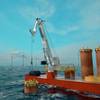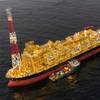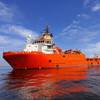The operator of the world’s largest and most modern molten sulphur tanker has enjoyed four years of near-continuous service, thanks in part to the ship’s innovative thermal maintenance system. Sulphur Carriers, Inc., a subsidiary of International Shipholding Corporation, keeps M/V Sulphur Enterprise at sea hauling around 24,000 long tons of molten sulphur per trip. “We’ve had zero freeze-ups and zero maintenance associated with the bolt-on piping and valve heating system,” says Peter Johnston, Sulphur Carriers’ VP of operations.
For reportedly the first time on any sulphur transport ship, a bolt-on heating system keeps the molten cargo flowing and the ship on schedule by preventing costly delays due to frozen pipes and valves. The innovative thermal maintenance system was engineered and built by Controls Southeast Inc., of Charlotte, N.C. Frozen lines and the resulting delays in loading and unloading can be very costly in lost transit time and additional port charges.
All the cargo-carrying pipes and valves aboard Sulphur Enterprise are surrounded by bolt-on oil-circulating ControTrace pipe heating elements and ControHeat valve jackets from CSI. Yet despite a harsh marine environment and a non-stop schedule, the bolt-on system has required neither repair nor replacement since the ship was launched. More important, it has eliminated the constant maintenance and frequent freeze-ups.
ControTrace bolt-on thermal maintenance modules are made of a shaped carbon steel tube, contoured to exactly mate with the outside diameter of process pipe. Sections are strapped lengthwise onto the piping, either individually or in heated, multiple element panels providing for excellent heat transfer.
ControHeat bolt-on jackets fit closely to valves, pumps, and other process system components. They are made up of patented, aluminum cast-to-fit pieces that match the component precisely. Embedded in the casting is a fabricated, steel, pressure-containing chamber through which flows the heating medium — steam, hot water/glycol or hot oil liquid/vapor. Independent pressure boundaries isolate the process stream from the heating medium to eliminate the possibility of cross-contamination.
Together, the ControTrace and ControHeat modules provide an integrated thermal maintenance system for the Sulphur Enterprise. “The success aboard a sulphur transport ship applies directly to land-based sulphur processing, recovery, and transport,” says CSI vice president Henry Gaines, “In fact, tanker service is a more demanding test. For sulphur handling today, bolt-on technology is definitely the better choice.”
Sulphur Enterprise was built by McDermott Shipyard, and since entering service in October 1994, the vessel has proven itself a maritime and chemical engineering success. According to Mr. Johnston, “The ship and particularly the thermal maintenance system is performing better than we ever expected. Sulphur Enterprise travels faster and discharges cargo faster than anticipated, and it has been really problem-free. For a project of this size and complexity, that’s remarkable.”
Under long-term charter to Freeport McMoran Sulphur, LLC New Orleans, the 524 ft. (159.7 m) Sulphur Enterprise is one of 16 operational molten sulphur tankers in the world.
Aboard the ship, four heated, fiberglass-insulated steel tanks in individual holds each contain about 6,000 tons of molten sulphur. They are filled and emptied through 1,345 ft. (410 m) of pipe controlled by approximately 35 wafer or butterfly valves. Like the big tanks, the transfer pipes and valves must be temperature controlled at all times to keep from freezing shut. The ship maintains its hectic schedule with no downtime for thermal system maintenance.
Sulphur remains liquid at temperatures from 240 to 310°F, but quickly increases in viscosity above 320°F and freezes at 240°F. The bolt-on thermal maintenance system of Sulphur Enterprise is designed to maintain its cargo at 278°F throughout loading, transit, and discharge. “We’re like a great, big floating thermos bottle,” says chief engineer Rick King. “If we allowed this cargo to freeze-up, we’d be a long time getting it moving again.”
The thermal maintenance system aboard the Sulphur Enterprise, designed by CDI Marine Company in Jacksonville, Fla., uses two hot oil circuits at 425 and 320°F. When the ship is underway, the primary circuit is heated to 425°F by the exhaust of the 9,840 hp Wärtsilä diesel powerplant. Alternatively, an auxiliary boiler heats the first oil circuit when the Sulphur Enterprise is in port or if more heat is needed. As a safety feature, the high temperature system is designed to dump excess heat into the ocean.
Each molten sulphur tank incorporates 2,200 ft. (670 m) of oil-circulating coils to keep the contents fluid. Sulphur in the transfer lines, above and below the decks, is heated by bolt-on systems with redundant oil paths. Sensors on the return side of the oil loop report oil temperature to six computers in the engineer’s office, deck office, and engine room. Display screens cue the ship’s engineer to problems, and remote actuators automatically vary the flow of oil to regulate line temperature.
The designers of the Sulphur Enterprise originally specified a welded jacket thermal maintenance system for the ship’s transfer pipe and valves. However, the shipyard’s estimate of fabrication costs reportedly found double-walled pipe an expensive solution, as the bolt-on system segments promised to be 25 percent cheaper. The 1,300 ft. (396.2 m) of pipe on the Sulphur Enterprise required more than 6,300 ft. (1,920 m) of heating elements. Pipes from .75 to 14 in. in diameter take from one single element to six elements installed as two panels of three elements each depending on the diameter and length of the pipe. ControHeat bolt-on jackets also cover 34 90-degree elbows, 8 and 12 in. diameter, and a collection of valves.
“We’ve never had to remove any thermal maintenance modules.” Mr. King observes, “In the unlikely event we have to make repairs, I can just unbolt one ControTrace module and bolt a new one on. We can replace a small panel without interrupting cargo operations.”
Significantly, no bolt-on heating element has required replacement in four years.
Circle 37 on Reader Service Card
Offshore
Worlds Largest FPSO Under Construction
The sophisticated and large Girassol FPSO — touted as the world’s largest with a 343,000-dwt capacity — is under construction at Hyundai in Korea for Bouygues Offshore and McDermott-EPTM. Starting in mid-2000, the FPSO will be employed in the Girassol field offshore Angola to store two million barrels of oil and process 260,000 barrels per day. The Girassol field will be operated by ELF, along with other major oil partners including Exxon, BP, Statoil, Norsk Hydro and Fina. Following are the vessel’s impressive particulars
Circle 40 on Reader Service Card
Length, o.a. 984 ft. (300 m)
Length, waterline 981 ft. (299 m)
Breadth, molded 195.5 ft. (59.6 m)
Depth, molded 100 ft. (30.5 m)
Design draft, molded 74.7 ft. (22.8 m)
Tropical draft, molded 76.25 ft. (23.2 m)
Scantling draft, molded 76.4 ft. (23.3 m)
DWT 343,000
Complement 140 + 40 persons
Design life of the hull scantling not less than 20 years w/o drydocking
Fatigue design life of hull 40 years
Station keeping system Spread mooring systems w/16 anchor legs
Noise
Private cabins 40db
Control rooms 55db
Workshops 70db
Cargo oil tank capacity 331,500 cu. m.
Slop tank capacity 12,000 cu. m.
Classification Bureau Veritas I 3/3 (-), + Offshore Service Barge - Oil Storage / Production, Deep Sea - site Girassol (Angola), ALM, HEL, MACH, AUTO, IG, LSA
Design Modification Could Save RoRos
As the debate regarding the survivability of RoRo vessels rages on, two researches last month claimed that curved car decks could improve safety. The researchers -- from the University of Strathclyde -- won a Royal Institution of Naval Architects competition to make ships safer, said curved decks could make RoRo ferries more stable. The researchers have reportedly produced two designs which they claim would prevent water from getting onto the car deck and capsizing the ship as it did in the Zeebrugge and Estonia disasters.
The first design calls for the deck at the bow and the stern to be three ft. (1 m) higher than in the middle of the ship. The cross section is convex with the center about 7.8 in. (20 cm) higher than the sides. If the ship was holed the design would limit the amount of water coming in and maintain the list of the ship, the researchers reason. The alternate proposal has a deck that is higher in the middle than at the bow and stern with a convex cross section. Water that enters the deck is pumped back out by pressure-operated valves.
Building It Up & Tearing It Down
cut 6-QQQ
Master Marine AS has developed a new type of offshore construction and decommissioning vessel. The concept is based on a column of a stabilized heavy lift vessel (HLV) which is able to handle topsides of up to 20,000 tons in one piece. The vessel, which is currently in the design stage with negotiation for construction underway, is designed to be self-propelled and outfitted with a dynamic positioning system. The HLV is moored vertically to suction anchors, deployed by the vessel, and the tie-down system is pre-tensioned in order to eliminate roll, pitch and heave motions during load transfer operations offshore.
Load transfer of topsides are performed by ballasting, alternatively de-ballasting of the HLV. Two 1,200-ton capacity cranes are employed for offshore construction and dismantling work. In addition to its primary tasks, the vessel could also be employed for pipe laying from reel (10,000-ton capacity), installation of cables and umbilicals, subsea installations and removal of templates and manifolds, well intervention and salvage operations.
Circle 39 on Reader Service Card
PROPULSION
1000th Wärtsilä 20 Built
cut 6-RRR
Inclusion in the Yearbook’s Marine Innovations section does not specifically mandate a product or vessel be new. Conversely, successful longevity more accurately represents a true innovation. This is the case with the well-regarded Wärtsilä 20 engine, the 1,000th which was recently produced at the Wärtsilä NSD factory in Vaasa, Finland. The unit was built for delivery to Halter Marine, and the 9-cyl. powerplant features an output of 1,485 kW (2,010 bhp). It will be installed as a main engine — together with another similar Wärtsilä 20 engine in a Hvide marine harbor tug.
The heavy duty, medium speed Wärtsilä 20 was launched in 1992, and has since been successfully installed as the main engine in tugs, coastal transport vessel, fishing boats and special vessels. The output represented by the 4, 5, 6, 8 and 9-cylinder units is from 720 to 1,620 kW (980 to 2,205 bhp) with a speed range of 720 to 1,000 rpm.
Circle 41 on Reader Service Card
Ulstein develops pulling propeller
A new propulsion concept using pulling propeller technology is under development at Ulstein Propeller, and units of up to 6MW are intended for applications including offshore and merchant tonnage
Ulstein Propeller has begun a project to develop a pulling propeller design for use with azimuthing and tractor drive units. The maximum rating of the new pulling propeller will be 6 MW and it will utilize a traditional gear wheel transmission.
Although this is recognized as a significant development in the industry it is not a new concept to Ulstein Propeller. Previously, the company successfully developed and marketed its Speed-Z design of high-speed pulling propeller unit.
This latest project builds on the company's experience in developing the Speed-Z and extends its application to larger commercial tonnage, including cruise ships and offshore vessels. The new pulling propeller is also expected to generate interest in naval markets where its inherent low noise characteristics should offer notable advantages.
Ulstein Propeller's target is to fully exploit the advantages of the pulling propeller working in association with a vertical drive strut aft of the propeller. There are a number of advantages in having a propeller in pulling mode rather than the conventional pushing mode. By removing the gear drive or shaft supports from in front of the propeller, the pulling propeller is able to operate in a optimum and near homogeneous water flow. Efficiency is thereby increased significantly.
Locating the propeller forward of the support strut will also contribute to reduced wear and tear, because the dynamic thrust and torque is of a completely different magnitude to the conventional pushing propeller's imperfect wake created by the forward support strut.
Propeller efficiency is still affected by the strut aft of the propeller. But its effect on total propulsion efficiency can be reduced by taking full advantage of the aft strut by designing its profile to counter rotational losses induced by the propeller. This will utilize the energy in the swirl aft in the propeller slipstream to create thrust in the same direction as the propeller thrust.
By adopting the pulling propeller concept, Rune Garen, research and development manager at Ulstein Propeller, believes that efficiencies can be increased by as much as 10 per cent. "Such an improvement is considerable by any modern day standard," says Mr Garen. "Already, evidence suggests an eight percent improvement is attainable but, by optimizing the hydrodynamic interactive package of propeller design and aft support strut, close to 10 percent must be a realistic target".
Speed-Z provided Ulstein Propeller with valuable experience in the design of pulling propellers. Ulstein learned that there is a very interesting interaction between the slipstream and the vertical strut, and that when the propeller is working in an almost homogeneous inflow; noise, vibration and dynamic torque are very low.
Ulstein has already commenced preliminary design of the new propulsion system and has begun analyzing the flow around the strut and the pod. Viscous CFD calculations will then be carried out and verified by model tests. The next phase will be to build and test a full-scale prototype by the end of next year.
Gas Turbine Power Comes To Cruise Shipping
cut 6-KKK
The Meyer Werft Shipyard in Papenburg, Germany has begun construction of the Radiance of the Seas, Royal Caribbean Cruises Ltd.’s innovative new ship which will be powered by a pair of GE gas turbine engines. The new luxury liner will measure 961 ft. (263 m) and be capable of carrying 2,500 passengers at more than 24 knots. The gas turbines will power two 360-degree rotatable podded drives. Pictured is RCCL chairman and CEO Richard Fain witnessing the initial “cutting of steel” at the computer-controlled cutting machine inside the yard’s building hall.
Circle 36 on Reader Service Card
Ship Design
Innovative Longliner Helps Redefine Market
cut 6-OOO
The Innaves designed longliner features many advanced, cost saving features.
Under the auspices of the European Eureka Program, under the Halios Project name, Spain’s Innaves has designed and built a new longliner design which reportedly offers many innovative technological advantages.
The Halios longliner has now been in successful operation for about a year. Innaves designed the ship top to bottom, including hull forms, the automated longlining system, the modified atmosphere in the holds for improved catch preservation, and the diesel-electric propulsion.
From the initial shipshape, it’s easy to see that this ship is different. As opposed to the traditional U forms incorporated for fishing ship designs in recent years, the Halios ship features a V form, giving it advantages in seakeeping and speed. It’s bulbous stern optimizes wake distribution.
For smooth vessel operations, the task of longline stowage, replacement of damaged branch lines and baiting operations have been automated. The Innaves system also is designed to automate bottom longlining with a monofilament main line, long monofilament branch lines and precision hook-baiting. The automatic system not only aids safety goals, but effectively eliminates six crew members.
Based on its shape and demanding operational requirements, the vessel demanded a rugged propulsion solution. Once in the fishery, the ship runs at high speeds while paying out longline. While hauling in, the vessel advances at between one and two knots, normally upwind, with often a need for greater power to retrieve broken tackle.
The Innaves designed solution includes a power system that during longline inhauling operations (approx. 18 hours per day) employs diesel-electric propulsion obtained from one genset. The genset powers a 110 kW alternate current motor through a frequency converter by vectorial control of the armature, which drives a PTO from the reduction gear.
Starting in March, Innaves began conducting extensive demonstrations of the system, with the financial backing of the FEDER funds and the European R&D Framework Plan (FAIR Program). A professional ship will be commissioned and the needed equipment installed to compare the improved effectiveness of the new systems and the traditional methods.
Circle 38 on Reader Service Card
Safety
Space Saving Cruise Tender Introduced
cut 6-JJJ
Umoe Schat-Harding launched its new compact, yet high-capacity cruise tender which reportedly offers cruise ship operators a cost- and space-saving alternative. The CTL 1200 cruise tender can accommodate 100 passengers when used as a tender, or 150 when used as a lifeboat. Meanwhile, the boat measures just 39 ft. (12 m) long and 14.7 ft. (4.5 m) wide. According to Arne Dybvik, the company’s marketing director, Umoe Schat-Harding has already received four orders for the CTL1200. The CTL1200 can be boarded in the stowed position, and has the standard Schat-Harding comfortable, functional and high standard interior. Installed as a package with Schat-Harding’s UNIC rolling pivot davit system, it will reportedly meet all Panama Canal requirements. The company stressed that the new unit will not replace the very successful CTL38 model.
Sponsored Content
Experience Custom Yacht Signs and Designs Tailored to Perfection!

April 2025
 Read the Magazine
Read the Magazine

 Read the Magazine
Read the Magazine
This issue sponsored by:

Looking Back: U.S. Maritime Industry Steps Up in Wake of FSK Bridge Collapse
Subscribe for
Maritime Reporter E-News
Maritime Reporter E-News is the maritime industry's largest circulation and most authoritative ENews Service, delivered to your Email five times per week







